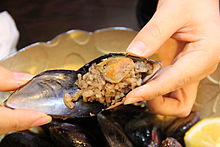Stuffed mussels
 | |
| Region or state | Turkey |
|---|---|
Stuffed mussels (Turkish: Midye dolma[1]) or Midye is a generic name for plump orange mussels, herbed and spiced rice, pine nuts, and occasionally currants. It is a popular and common street food snack in the coastal and other areas of Turkey such as Istanbul, İzmir and Bodrum. Midye dolma is sold at all hours and is normally eaten with lemon juice freshly squeezed over them so that the mussel and rice are not dry and the spices are easily mixed and tasted.
History[]
The historical preparation of the midye dolma is generally attributed to Armenians in the Ottoman Empire. According to TH. Maggakis' 1888 work Bizans Salnamesi Armenians had used big mussels and prepared the dish using sheep's tail fat or "zibir yağı", a solid fat imported from Siberia.[2] Balıkhane Nazırı Ali Rıza Bey (1842-1928) also notes that in brickworks owner Şahbaz Efendi's Armenian cook was preparing stuffed mussels.[3] During the 19th century it was reported that İstanbulite Turkish women were also cooking stuffed mussels.[3]
In the 1960s midye dolma preparation and business has become to be dominated by immigrants from Mardin, who had at the time recently immigrated to İstanbul's Galata district. In the following decades they have kept the market share and today, most of the food carts are still being operated by people from Mardin. It was noted that there are flavor differences between Armenian-style and Mardin-style stuffed mussels, the latter being more spicy.[2]
Contamination and pollution[]
In a 2020 study that examined the presence of microplastics (MP) in stuffed mussels sold in 5 Turkish cities, it has been reported that 100 grams of stuffed mussels on average contained around 5.8 MP pieces. The study also concluded that İstanbul had the highest MP quantity per mussel.[4]
A study from 2011 reported that approximately 50% of samples of street bought mussels from Ankara were not suitable for consumption in accordance with due to the Salmonella sp. content. The study also found out that 30% of the samples were contaminated with E. coli, 80% with B. cereus, 76.6% with S. aureus and 13.3% with Clostridium perfringens and were not suitable for consumption.[5] Another study from 2007 showed that both lemon juice and lemon dressing use caused slight decrease in Salmonella Typhimurium as an immediate inhibitor, and this effect increased by time.[6]
In another study published in December 2021 the metal/metalloid levels in stuffed mussels were analyzed. The results showed that the levels of Cr, As, and Cd found in stuffed mussel posed a carcinogenic risk for almost all locations and consumer groups, while it was found that Pb did not pose any carcinogenic risk.[7]
See also[]
References[]
- ^ New York Media, LLC (22 February 1993). New York Magazine. New York Media, LLC. pp. 69–. ISSN 0028-7369.
- ^ a b "Kutsal Midye". Agos (in Turkish). Retrieved 2020-09-23.
- ^ a b "Bir sokak aperatifi olan midye dolmanın hikâyesi". aksam.com.tr (in Turkish). Retrieved 2020-09-23.
- ^ Gündoğdu, Sedat; Çevik, Cem; Ataş, Nihan Temiz (2020-10-01). "Stuffed with microplastics: Microplastic occurrence in traditional stuffed mussels sold in the Turkish market". Food Bioscience. 37: 100715. doi:10.1016/j.fbio.2020.100715. ISSN 2212-4292.
- ^ Ates, Mustafa; Ozkizilcik, Asli; Tabakoglu, Cengiz (2011-07-01). "Microbiological Analysis of Stuffed Mussels Sold in the Streets". Indian Journal of Microbiology. 51 (3): 350–354. doi:10.1007/s12088-011-0174-6. ISSN 0973-7715. PMC 3209921. PMID 22754015.
- ^ Kişla, Duygu (2007-12-01). "Effectiveness of Lemon Juice in the Elimination of Salmonella Typhimurium in Stuffed Mussels". Journal of Food Protection. 70 (12): 2847–2850. doi:10.4315/0362-028X-70.12.2847. ISSN 0362-028X.
- ^ Köşker, Ali Rıza; Gündoğdu, Sedat; Ayas, Deniz; Bakan, Mısra (2022-03-01). "Metal levels of processed ready-to-eat stuffed mussels sold in Turkey: Health risk estimation". Journal of Food Composition and Analysis. 106: 104326. doi:10.1016/j.jfca.2021.104326. ISSN 0889-1575.
- Turkish cuisine dolmas and sarmas
- Meze
- Street food in Turkey